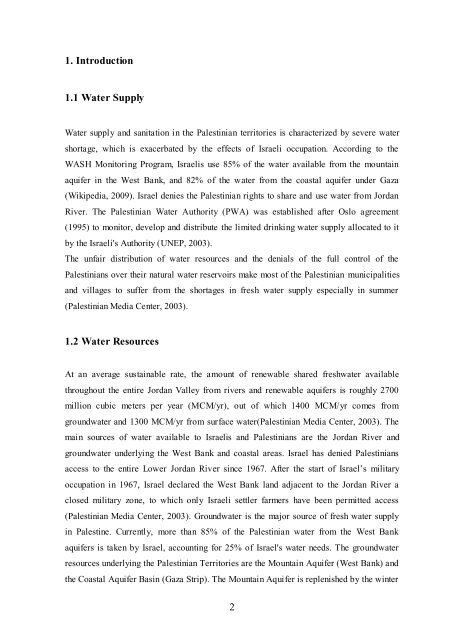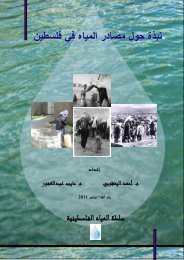Quds University Small Scale Waste Water Treatment Plants in West ...
Quds University Small Scale Waste Water Treatment Plants in West ...
Quds University Small Scale Waste Water Treatment Plants in West ...
You also want an ePaper? Increase the reach of your titles
YUMPU automatically turns print PDFs into web optimized ePapers that Google loves.
1. Introduction<br />
1.1 <strong>Water</strong> Supply<br />
<strong>Water</strong> supply and sanitation <strong>in</strong> the Palest<strong>in</strong>ian territories is characterized by severe water<br />
shortage, which is exacerbated by the effects of Israeli occupation. Accord<strong>in</strong>g to the<br />
WASH Monitor<strong>in</strong>g Program, Israelis use 85% of the water available from the mounta<strong>in</strong><br />
aquifer <strong>in</strong> the <strong>West</strong> Bank, and 82% of the water from the coastal aquifer under Gaza<br />
(Wikipedia, 2009). Israel denies the Palest<strong>in</strong>ian rights to share and use water from Jordan<br />
River. The Palest<strong>in</strong>ian <strong>Water</strong> Authority (PWA) was established after Oslo agreement<br />
(1995) to monitor, develop and distribute the limited dr<strong>in</strong>k<strong>in</strong>g water supply allocated to it<br />
by the Israeli's Authority (UNEP, 2003).<br />
The unfair distribution of water resources and the denials of the full control of the<br />
Palest<strong>in</strong>ians over their natural water reservoirs make most of the Palest<strong>in</strong>ian municipalities<br />
and villages to suffer from the shortages <strong>in</strong> fresh water supply especially <strong>in</strong> summer<br />
(Palest<strong>in</strong>ian Media Center, 2003).<br />
1.2 <strong>Water</strong> Resources<br />
At an average susta<strong>in</strong>able rate, the amount of renewable shared freshwater available<br />
throughout the entire Jordan Valley from rivers and renewable aquifers is roughly 2700<br />
million cubic meters per year (MCM/yr), out of which 1400 MCM/yr comes from<br />
groundwater and 1300 MCM/yr from surface water(Palest<strong>in</strong>ian Media Center, 2003). The<br />
ma<strong>in</strong> sources of water available to Israelis and Palest<strong>in</strong>ians are the Jordan River and<br />
groundwater underly<strong>in</strong>g the <strong>West</strong> Bank and coastal areas. Israel has denied Palest<strong>in</strong>ians<br />
access to the entire Lower Jordan River s<strong>in</strong>ce 1967. After the start of Israel’s military<br />
occupation <strong>in</strong> 1967, Israel declared the <strong>West</strong> Bank land adjacent to the Jordan River a<br />
closed military zone, to which only Israeli settler farmers have been permitted access<br />
(Palest<strong>in</strong>ian Media Center, 2003). Groundwater is the major source of fresh water supply<br />
<strong>in</strong> Palest<strong>in</strong>e. Currently, more than 85% of the Palest<strong>in</strong>ian water from the <strong>West</strong> Bank<br />
aquifers is taken by Israel, account<strong>in</strong>g for 25% of Israel's water needs. The groundwater<br />
resources underly<strong>in</strong>g the Palest<strong>in</strong>ian Territories are the Mounta<strong>in</strong> Aquifer (<strong>West</strong> Bank) and<br />
the Coastal Aquifer Bas<strong>in</strong> (Gaza Strip). The Mounta<strong>in</strong> Aquifer is replenished by the w<strong>in</strong>ter<br />
2




